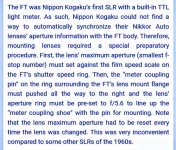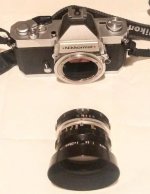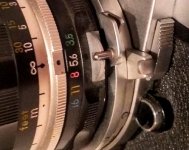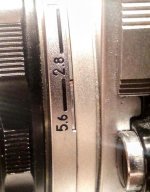Tim Murphy
Well-known
Dear Board,
I have no problem removing a lens, but putting one back on is a challenge for me.
I know that the ring with the aperture pin must be moved to the far right as you view the camera from the front. I know you must set the aperture on the lens you want to mount to f5.6.
I do that. The lens engages the pin and settles in the mount. From the front I turn the lens to the left and the bayonet locks securely.
Now the fun begins. I know you need to set the lens maximum aperture so that it indicates such on the ring with the pin. Most times it does but sometimes it does not. Common wisdom says cycle to the minimum aperture and then back to the maximum aperture until the lens registers.
When I turn a non-A-1 lens like the 50mm f2.0 that I own to the minimum aperture it seems to go f18 and lock the entire mechanism up tighter than a frogs a-hole, and they are waterproof!
I'm getting quite skilled at removing the front plate on top of the prism and resetting everything but I have some questions? As you view my picture the cog on the far left has dropped 2 positions. The cog that runs across the right 2/3 rd's of lens also drops, and is the real culprit for the jam.
Do the spindly little springs wear out over time? They certainly don't look very robust, but I own 3 Nikkormats and none of the springs have broken. I've carefully dosed all pivot points with RONSOL and carefully cleaned up with cotton swabs.
There must be something I am doing wrong. or something I could do to prevent this issue?
Can anyone help a brother out?
Regards,
Tim Murphy
Harrisburg, PA 🙂
 Nikkormat (1) by Tim Murphy, on Flickr
Nikkormat (1) by Tim Murphy, on Flickr
I have no problem removing a lens, but putting one back on is a challenge for me.
I know that the ring with the aperture pin must be moved to the far right as you view the camera from the front. I know you must set the aperture on the lens you want to mount to f5.6.
I do that. The lens engages the pin and settles in the mount. From the front I turn the lens to the left and the bayonet locks securely.
Now the fun begins. I know you need to set the lens maximum aperture so that it indicates such on the ring with the pin. Most times it does but sometimes it does not. Common wisdom says cycle to the minimum aperture and then back to the maximum aperture until the lens registers.
When I turn a non-A-1 lens like the 50mm f2.0 that I own to the minimum aperture it seems to go f18 and lock the entire mechanism up tighter than a frogs a-hole, and they are waterproof!
I'm getting quite skilled at removing the front plate on top of the prism and resetting everything but I have some questions? As you view my picture the cog on the far left has dropped 2 positions. The cog that runs across the right 2/3 rd's of lens also drops, and is the real culprit for the jam.
Do the spindly little springs wear out over time? They certainly don't look very robust, but I own 3 Nikkormats and none of the springs have broken. I've carefully dosed all pivot points with RONSOL and carefully cleaned up with cotton swabs.
There must be something I am doing wrong. or something I could do to prevent this issue?
Can anyone help a brother out?
Regards,
Tim Murphy
Harrisburg, PA 🙂
 Nikkormat (1) by Tim Murphy, on Flickr
Nikkormat (1) by Tim Murphy, on Flickr




